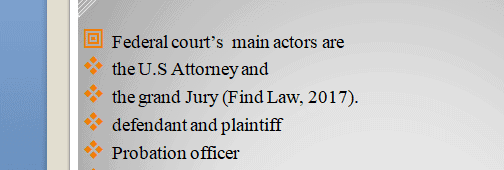There are different actors in the courtroom, and each has a specific role in how a trial or session will progress.
There are different actors in the courtroom, and each has a specific role in how a trial or session will progress. There are also differences between the federal and state courts that are important to understand. In this assignment, you outline details about the actors in the courtroom and federal and state courts. This assignment is meant to help you understand the courts and prepare you to participate in the courtroom process.
Imagine you are a court administrator for the local superior court. You have been asked to speak to a high school civics class. Specifically, the teacher would like you to provide a general overview of federal and state courts and discuss the primary actors in each court system.
Create an 4- to 8-slide Microsoft® PowerPoint® presentation in which you:
Identify actors in the courtroom.
Who are the actors in federal courts and state courts? (Include actors the 2 courts have in common and any actors who are different.)
What are their responsibilities?
Why is it important for these responsibilities to be fulfilled adequately? (Consider the effect of overzealousness compared to the effect of underperformance.)
Identify what is different between these actors in federal courts from the same actors in the state courts.
Judges
Defense attorneys
Prosecutors
Juries
Contrast federal and state (your state or the state you’re from) courts (consider creating a diagram/chart/table).
Structure
Jurisdiction
Roles of each court
Case types
Include detailed speaker notes. These speaker notes are what you would say if you were to give this presentation in person.
Include at least 1 illustration in your slides, such as a chart, diagram, table, and so on.
Cite a minimum of 2 sources (1 source for state courts and 1 source for federal courts).
Answer preview to there are different actors in the courtroom, and each has a specific role in how a trial or session will progress.
7 slides



